September 2 - 8, 2018: Issue 374
University Of Sydney & Surrounds To Be Heritage Listed
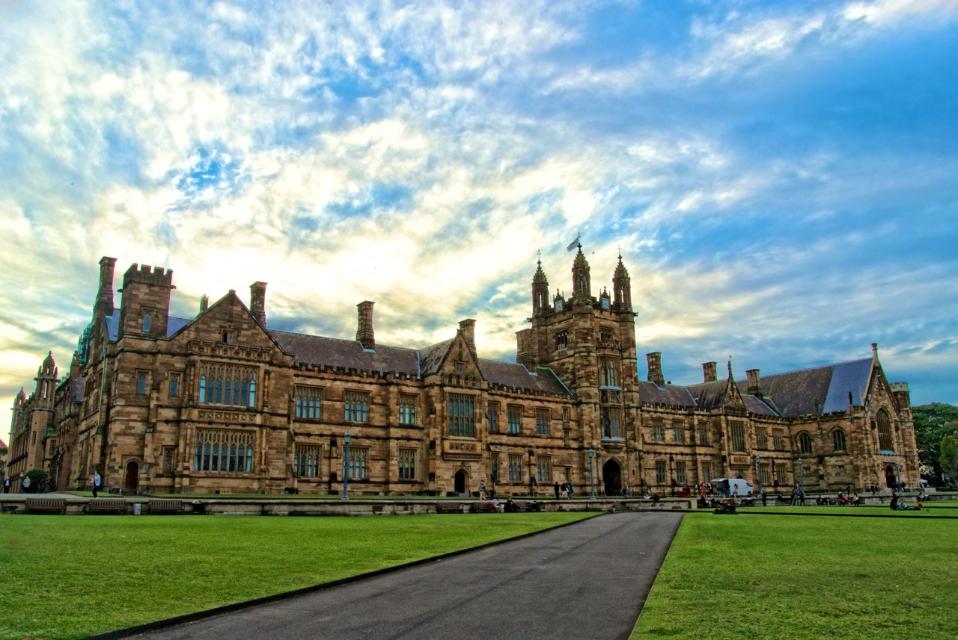
University Of Sydney And Surrounds To Be Heritage Listed
August 27, 2018
By University of Sydney
The University of Sydney, University Colleges and Victoria Park have today been recognised as places of state significance, with the NSW Heritage Minister announcing the area will be listed on the State Heritage Register.
NSW Heritage Minister Gabrielle Upton has today announced the University’s Camperdown campus, associated residential colleges and neighbouring Victoria Park have been approved to be listed on the State Heritage Register.
In making the announcement Minister Upton said, “It is only fitting that Australia’s oldest university should be on our State Heritage Register.”
“This is a time to celebrate, to reflect on the history and the culture of this unique cultural landscape, and to preserve and protect the heritage values of the University of Sydney, University College and Victoria Park for years to come.”
Places in New South Wales are heritage listed when the Heritage Minister deems them important enough to save and protect for future generations.
A formal listing means it is a place revealing the story of Australia’s past and ensures it is safeguarded and enriches the future.
The University, often recognised as one of the world's most beautiful campuses, and its surrounds will join other registered heritage including the Queen Victoria Building, Sydney Town Hall, the Sydney Opera House and the Sydney Harbour Bridge.
“This announcement demonstrates our commitment as curators and caretakers of some of Sydney’s most historic buildings,” said Vice-Chancellor and Principal Dr Michael Spence.
"We recognise we sit on the land of the Cadigal people of the Eora nation and we are immensely proud to be custodians of this site that we share with the people of NSW." - Dr Michael Spence
“Many people who have made significant contributions to our society have either studied, taught or undertaken research here and many more will continue to do so long into the future,” said Dr Spence.
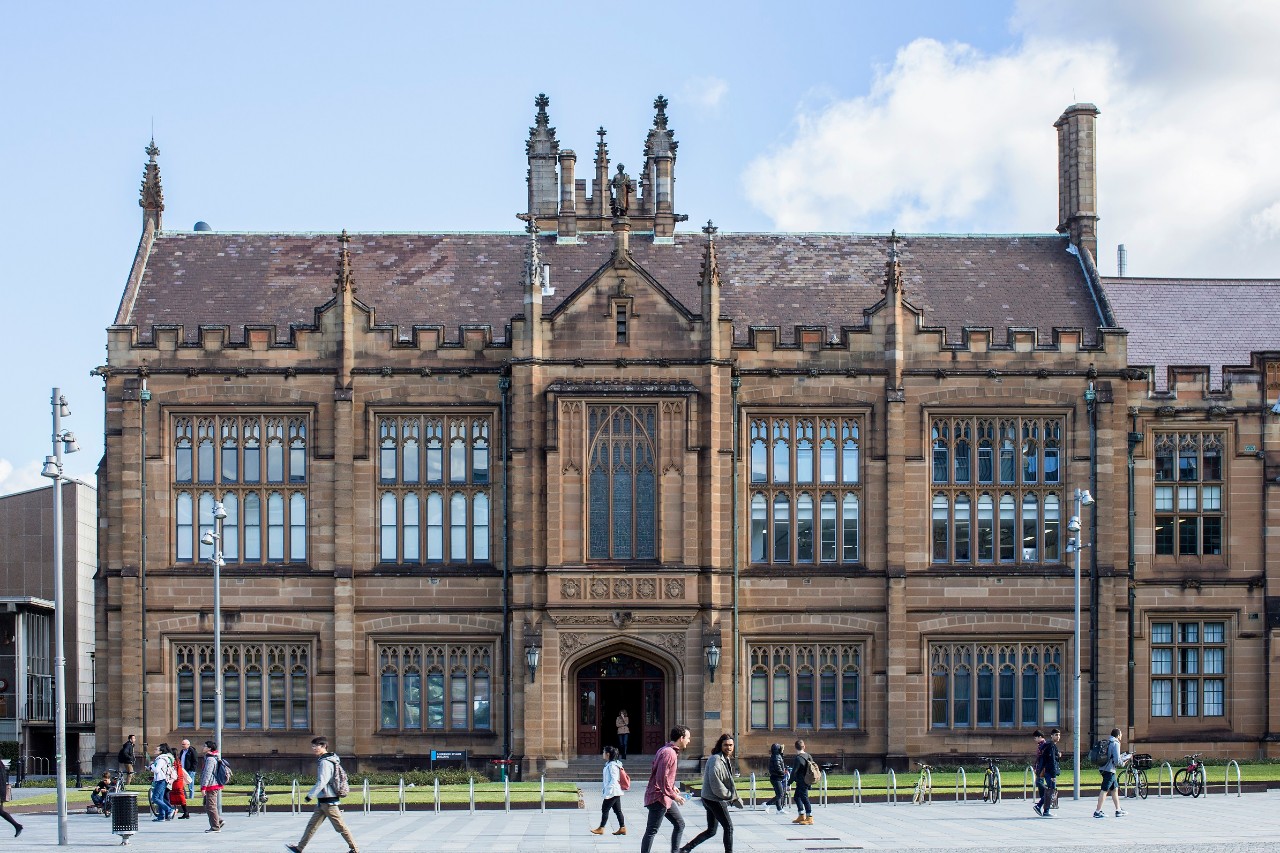
The Anderson Stuart Building
As part of the listing, a number of the University’s most well-known buildings have been marked as having ‘exceptional’ significance to the state, including the Quadrangle, the Old Teacher’s College, the Holme Building, the Anderson Stuart Building and the JD Stewart Building.
“The Main Quadrangle Building, the Anderson Stuart Building and the Gate Lodges comprise what is arguably the most important group of Gothic and Tudor Revival style architecture in New South Wales and potentially Australia,” said Ian Kelly, the University of Sydney’s Heritage Consultant.
“Throughout history a number of architects have influenced the site, from Edmund Blacket in the 1850s, Professor Leslie Wilkinson in the 1920s and the Government Architect’s Office in 1960s, just to name a few.
“In particular, Blacket’s location of the Great Hall and the eastern side of the Quadrangle, built between 1854 and 1862, utilised the existing landscape to provide a dramatic presentation of the University on approach from the city, a setting that still remains to this day.”
The listing also recognises the University’s associated residential colleges, including the Women’s College, the first university college for women in Australia, which was individually listed on the State Heritage Register in 2005.
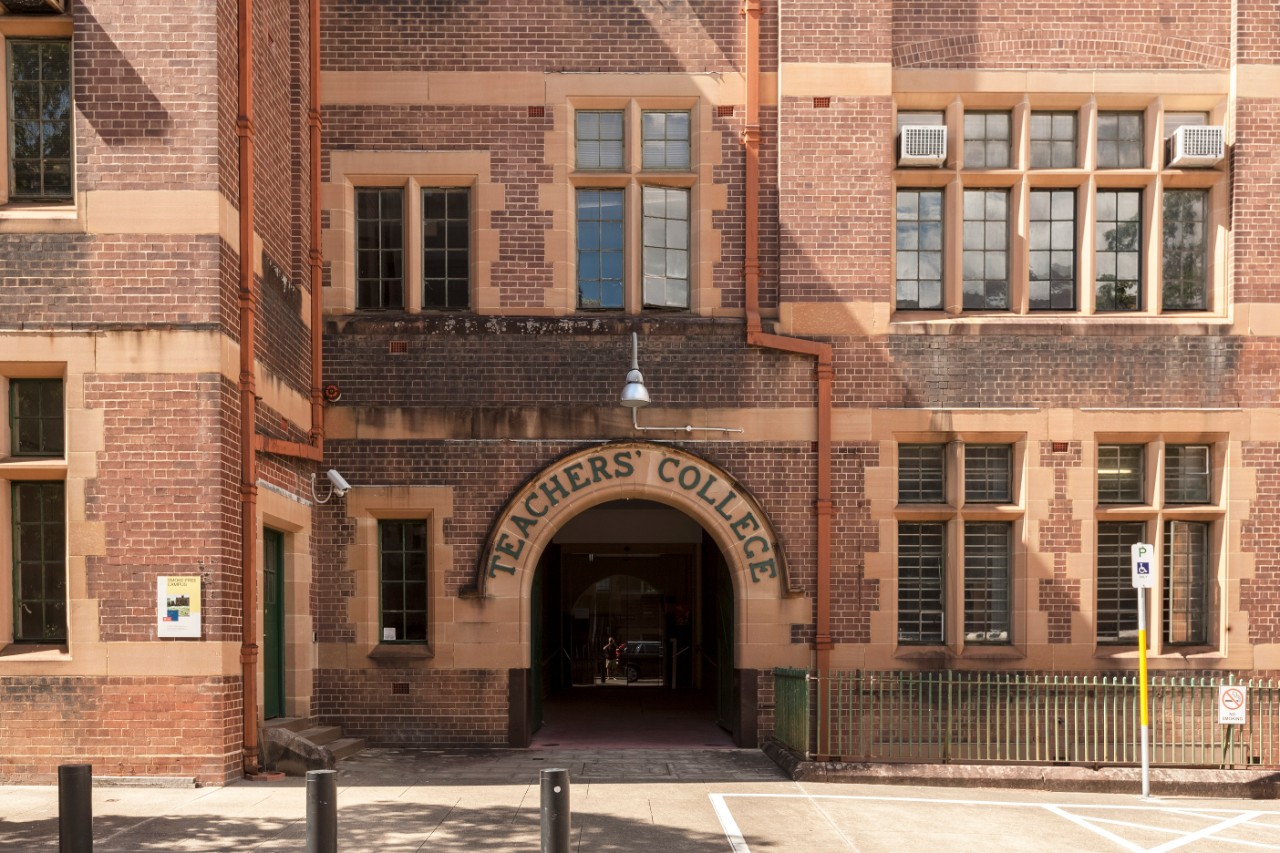
Old Teachers' College
Building a history of education
The site on which the Camperdown campus sits, along with the university colleges and Victoria Park, has long been tied to Aboriginal Australians, with the people of the Cadigal and Wangal groups living in the area and using the rich landscape, including a spring that drained to Blackwattle Bay.
In 1790, part of the ‘Kanguroo Ground’ near the present-day junction of Parramatta and City Roads was set aside as reserves for Crown, church and school purposes and used for pasturage of stock.
The University of Sydney was established in 1850 by William Charles Wentworth as Australia’s first university, with the ideal that children of any standing could earn a university education.
The structure of the University as a non-denominational, non-residential institution – with the residential colleges to be established around the main buildings by the four religious denominations of the day – represented a uniquely Australian approach to university design.
The first University buildings to be constructed formed the basis of what is now the Quadrangle, designed by Edmund Blacket between 1855 and 1862.
The Quadrangle was not fully completed for over 100 years, when the Western towers and cloisters were built in 1963.
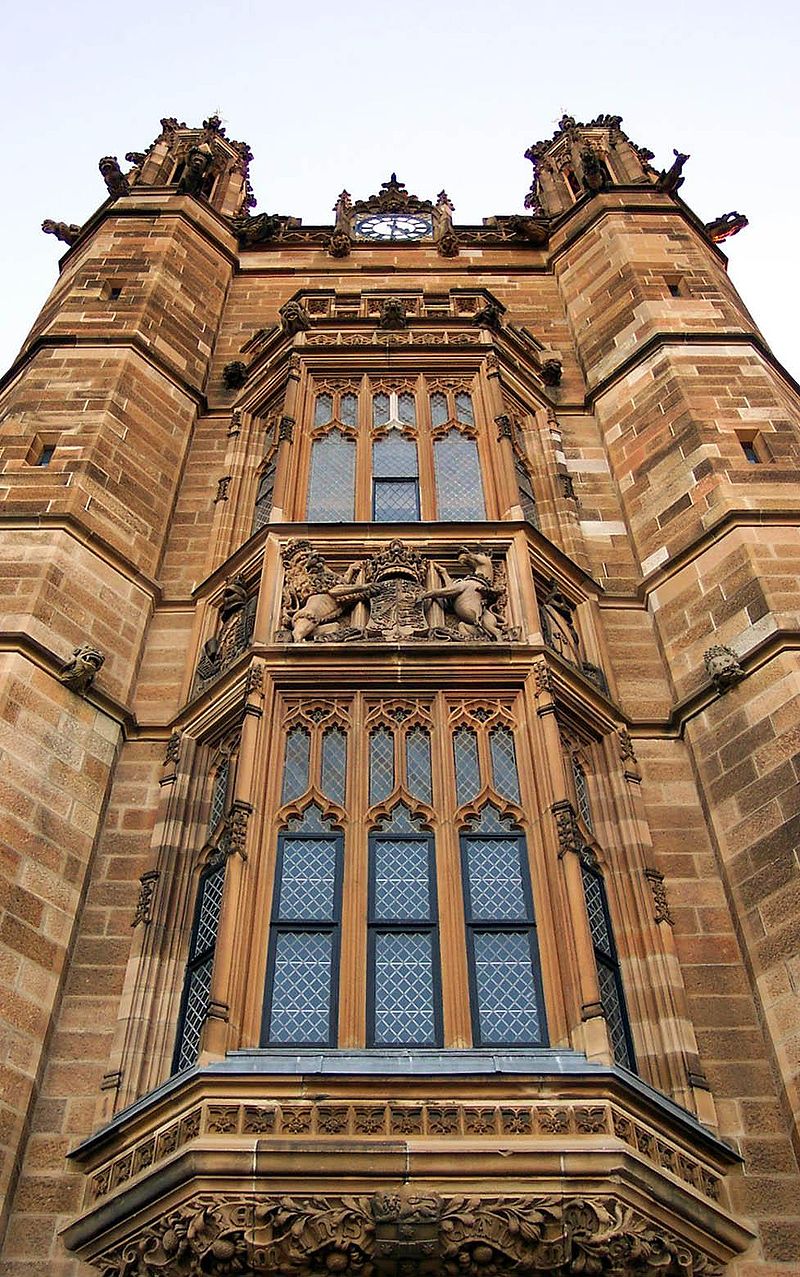
The Great Tower (completed 1862) is on the eastern side of the Main Quadrangle
Timeline of significant building work
1854 to 1963 - Main Quadrangle
1885 – Anderson Stuart Building
1887 – Macleay Building
1908 – John Woolley Building
1910 to 1912 – Holme Building
1910 to 1912 – J.D. Stewart Building
1911 to 1916 – R.D. Watt
1914-25 – Teachers College
1925 – Physics Building
1930 – Edward Ford Building
1949 – R.C. Mills Building
1956 – Chemistry Building
1962 – Fisher Library
2009 – New Law Building
2012 – Charles Perkins Centre
The University of Sydney (informally, USYD) is an Australian public research university in Sydney, Australia. The university is colloquially known as one of Australia's sandstone universities. Its campus is ranked in the top 10 of the world's most beautiful universities by the British Daily Telegraph and The Huffington Post, spreading across the inner-city suburbs of Camperdown and Darlington. The university comprises 9 faculties and university schools, through which it offers bachelor, master and doctoral degrees. In 2014 it had 33,505 undergraduate and 19,284 graduate students.
The MacLaurin Hall - photo by and courtesy Jason Tong
In 1848, in the New South Wales Legislative Council, William Wentworth, a graduate of the University of Cambridge and Charles Nicholson, a medical graduate from the University of Edinburgh Medical School, proposed a plan to expand the existing Sydney College into a larger university. Wentworth argued that a state secular university was imperative for the growth of a society aspiring towards self-government, and that it would provide the opportunity for "the child of every class, to become great and useful in the destinies of his country". It would take two attempts on Wentworth's behalf, however, before the plan was finally adopted.
The university was established via the passage of the University of Sydney Act, on 24 September 1850 and was assented on 1 October 1850 by Sir Charles Fitzroy. Two years later, the university was inaugurated on 11 October 1852 in the Big Schoolroom of what is now Sydney Grammar School. The first principal was John Woolley, the first professor of chemistry and experimental physics was John Smith. On 27 February 1858 the university received its Royal Charter from Queen Victoria, giving degrees conferred by the university rank and recognition equal to those given by universities in the United Kingdom.
Originally housed in what is now Sydney Grammar School, in 1855 the government granted land in Grose Farm to the university, three kilometres from the city, which is now the main Camperdown campus. The architect Edmund Blacket designed the original Neo-Gothic sandstone Quadrangle and Great Tower buildings, which were completed in 1862. The rapid expansion of the university in the mid-20th century resulted in the acquisition of land in Darlington across City Road. The Camperdown/Darlington campus houses the university's administrative headquarters, and the Faculties of Arts, Science, Education and Social Work, Pharmacy, Veterinary Science, Economics and Business, Architecture, and Engineering. It is also the home base of the large Sydney Medical School, which has numerous affiliated teaching hospitals across the state.
By 1859, the university had moved to its current site in the Sydney suburb of Camperdown.
The university has a number of halls of residence (based on research-lead living-learning principles) and residential colleges, each with its own distinctive style and facilities. All offer a wide range of cultural, social, sporting and leadership activities along with targeted academic support in a supportive communal environment. The Halls of Residence are owned and operated by the University Accommodation Service. Starting in 2013, the University committed to creating the Halls of Residence (an additional 4,000-6,000 residential places) at an affordable price to enhance the educational experience of living on campus and to offer more students a rich academic environment in which to live.
- The Queen Mary Building
- Abercrombie Student Accommodation
- Regiment Hall (Opening in 2018)
The University Student Accommodation Service were awarded the Asia-Pacific Student Housing Operation of the Year & Excellence in Facility Development and Management in 2016.
The Student Accommodation Service and the Mana Yura Student Support Service were the first in Australia to implement an Aboriginal and Torres Strait Islander On-Campus Residence Halls Scholarship Guarantee. Additionally, the University owns and operates International House.
Affiliated with the University are six religiously denominated colleges. Unlike some residential colleges in British or American universities, the colleges are not affiliated with any specific discipline of study.
- International House
- St John's College
- St Andrew's College
- St Paul's College
- Sancta Sophia College
- Wesley College
- The Women's College
- Mandelbaum House
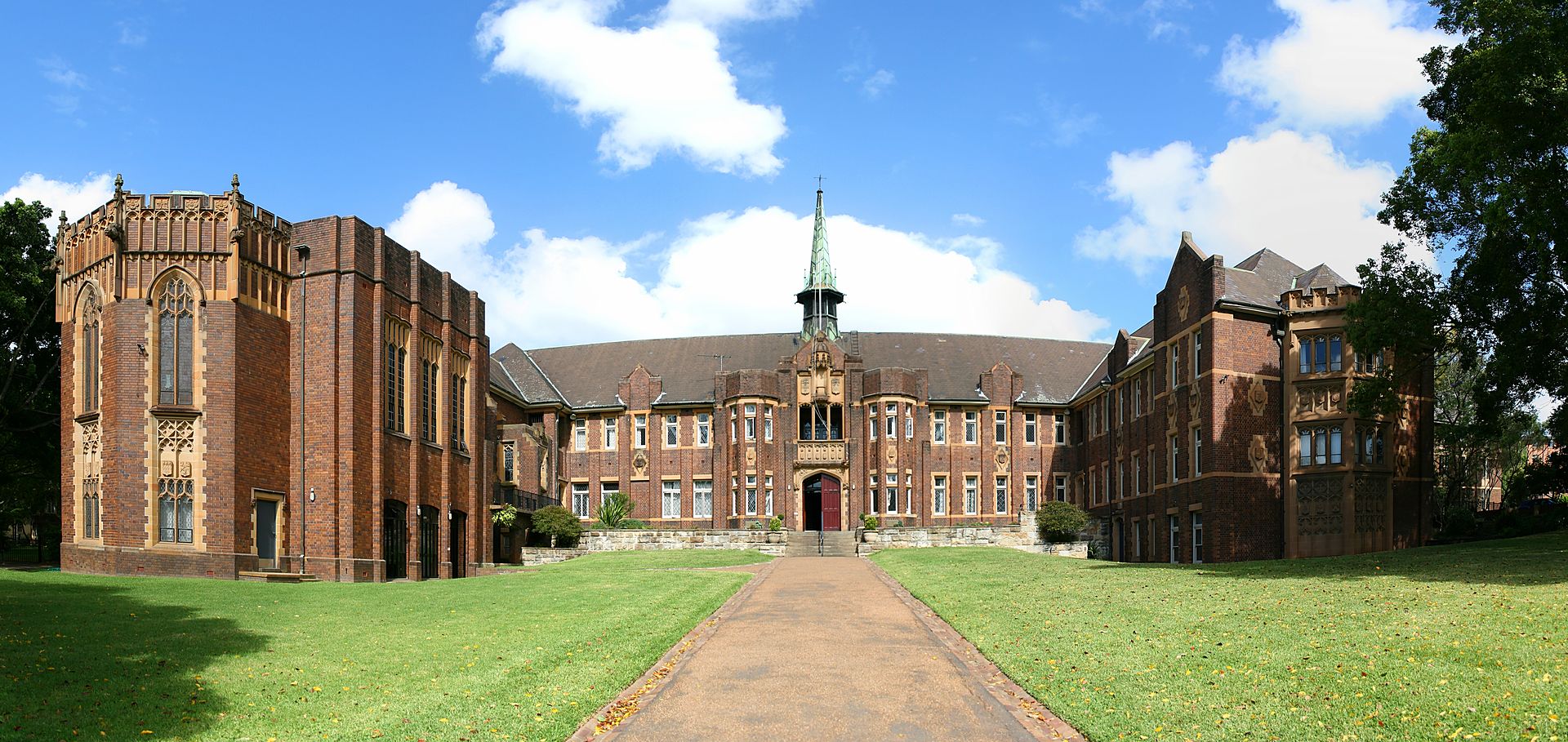
Wesley College - photo by and courtesy Toby Hudson
The MacLaurin Hall
NSW Government Architect Walter Liberty Vernon with George McCrae
Construction years: 1902-1909
Maclaurin Hall, the former Fisher Library is Gothic Revival in style. The building was designed to form a corner to the Quadrangle and is two storey to the Quadrangle and three storey to Manning Road. The southern facade features a central bay flanked by two turrets. Blind tracery follows the line of the gable which terminates in a carved finial, a motif continued from the earlier ranges to the east. The stepped buttresses to the southern elevation emphasise the form of the building similar to the chapels of the medieval colleges. The reading room was located on the upper floor and these windows received the most elaborate tracery. The hammerbeam roof of the reading room/hall is constructed of cedar and is based on English prototypes with which the Government Architect Walter Liberty Vernon was familiar.
The roof of the hall is clad with copper/muntz metal. A distinctive feature of the building is its elaborate skyline, formed by the pinnacles which terminate the buttresses, the carved finials to the gables and the central fleche. The louvred fleche, which is constructed of timber, is clad with lead. This motif was used on all of the faculty buildings designed by Vernon and may be based on the elaborate fleche added to Cardiff Castle during the extensive renovations by Burges. Intended to vent gas lit buildings the elements were developed into distinctive roofscape elements.
The Grant of Arms was made by the College of Arms in 1857. The grant reads:
Argent on a Cross Azure an open book proper, clasps Gold, between four Stars of eight points Or, on a chief Gules a Lion passant Guardant also Or, together with this motto "Sidere mens eadem mutato" to be borne and used forever herafter by the said University of Sydney on their Common Seal, Shields or otherwise according to the Law of Arms.
The use of eight-pointed stars was unusual for arms at the time, although they had been used unofficially as emblems for New South Wales since the 1820s and on the arms of the Church of England Diocese of Australia in 1836.
According to the university, the Latin motto Sidere mens eadem mutato can be translated to "the stars change, the mind remains the same." Francis Merewether, later Vice Provost, in 1857 proposed "Coelum non animum mutant" from Horace (Ep.1.11.27) but after objections changed it to a metrical version including "Sidus" (Star), a neat reference to the Southern Cross and perhaps the Sydney family link with Sir Philip Sidney's "Astrophel (Star-Lover) & Stella (Star)". ]
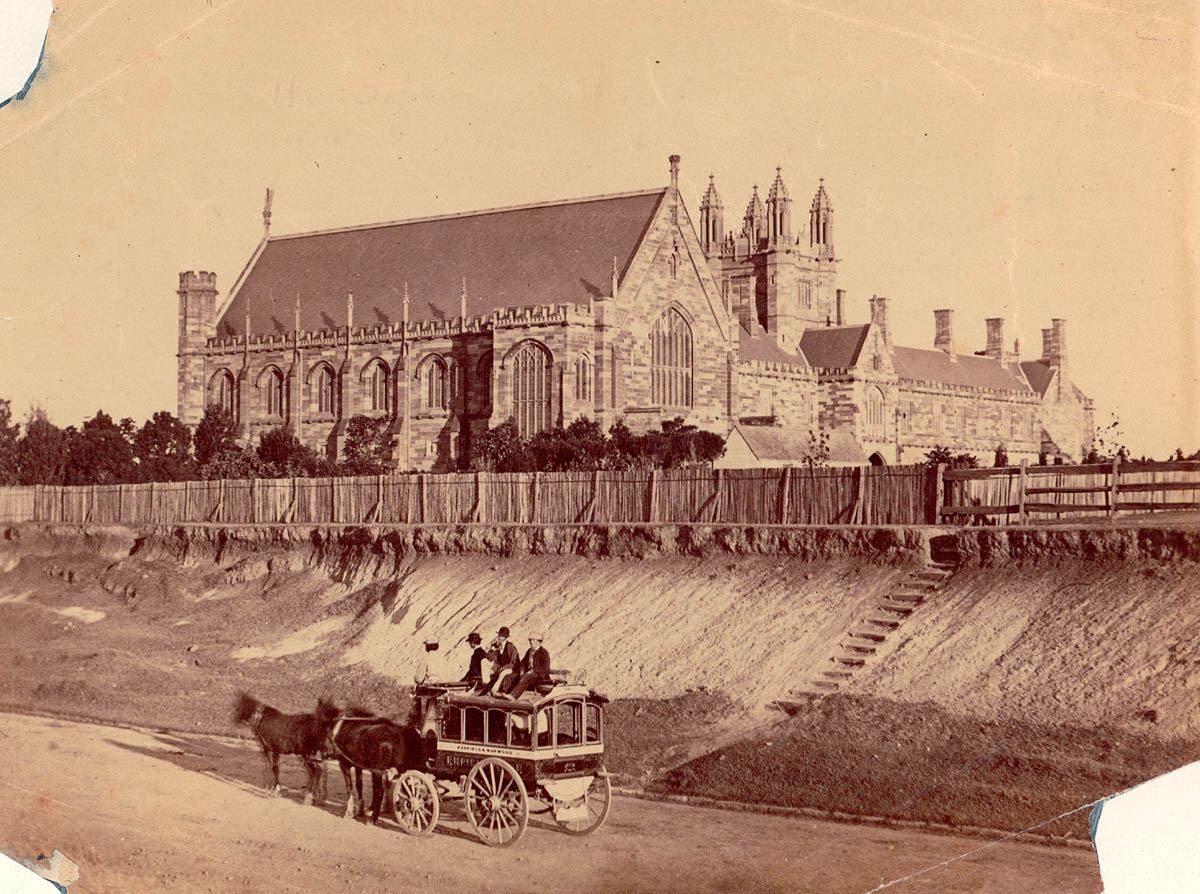
The University of Sydney in the early 1870s, viewed from Parramatta Road. Photo courtesy State Library of NSW
In 1858, the passage of the electoral act provided for the university to become a constituency for the New South Wales Legislative Assembly as soon as there were 100 graduates of the university holding higher degrees eligible for candidacy. This seat in the Parliament of New South Wales was first filled in 1876, but was abolished in 1880 one year after its second member, Edmund Barton, who later became the first Prime Minister of Australia, was elected to the Legislative Assembly.
Five Nobel and two Crafoord laureates have been affiliated with the university as graduates and faculty. The university has educated seven Australian prime ministers, two Governors-General of Australia, nine state governors and territory administrators, and 24 justices of the High Court of Australia, including four chief justices. Sydney has produced 110 Rhodes Scholars and several Gates Scholars. [1.]
St. John's College, University of Sydney
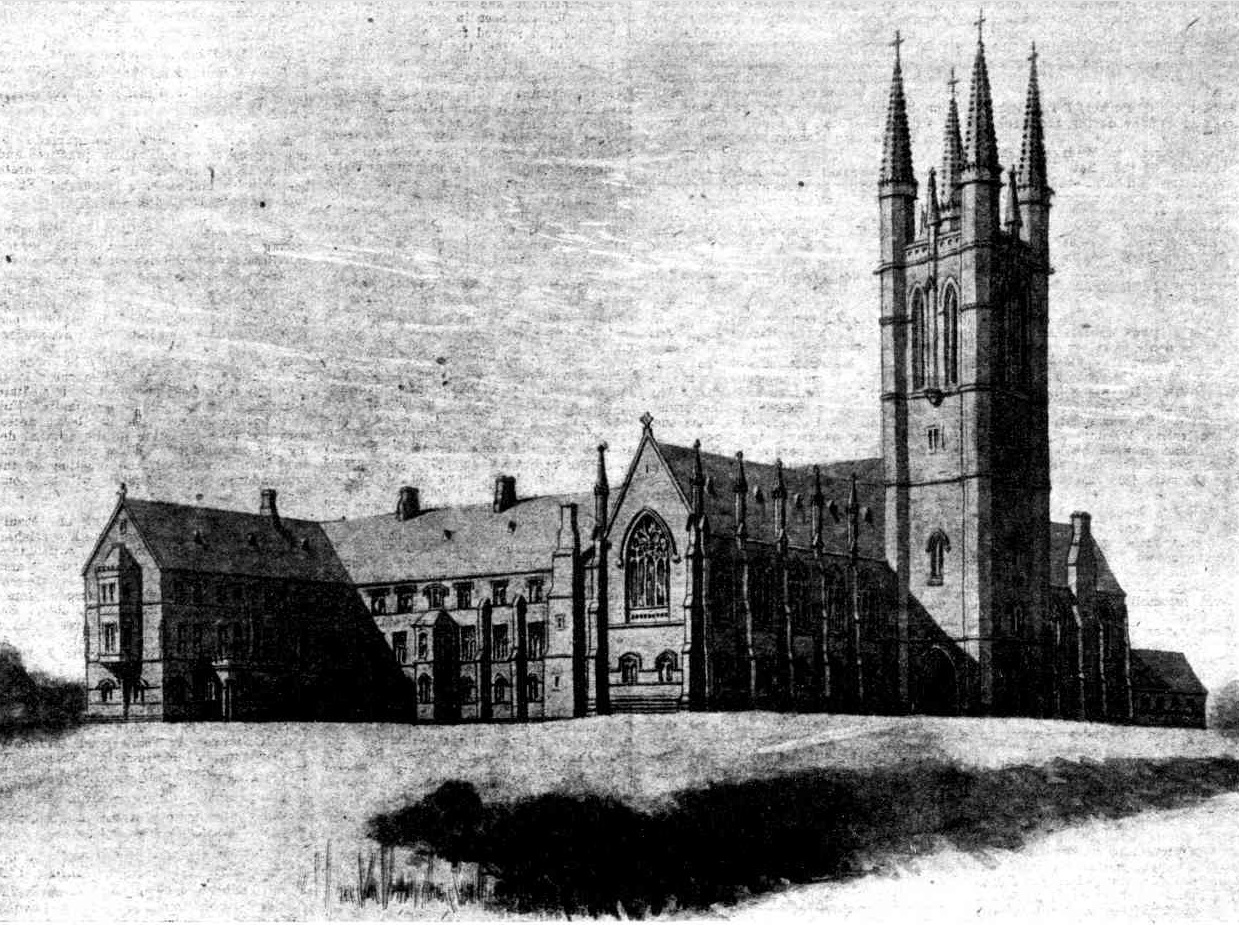
THE COMPLETE DESIGN FOR ST. JOHN'S COLLEGE, SYDNEY UNIVERSITY.
The management of 'Santa Sophia' Hall is to be congratulated warmly on tho munificent gift of £9000, made to the institution by Lady Sheldon. By means of it a new wing is about to be erected, which will provide for the accommodation, at the beginning of the next University year, of 20 additional women students. The donation came not a moment too soon; for the existing accommodation had already been exhausted, and it was plain that students would, have to be turned away at the beginning of 1928. It is much to be desired that some equally generous, friend of higher education would do the same for St. John's College. During the whole of the present year, the college has been crowded out, and it is inevitable that students must be refused admittance next year, unless some kind friend comes along and plays the fairy-godmother. A general appeal is, of course, out of the question. His Grace the Archbishop has his hands full in providing for the speedy completion of St. Mary 's Cathedral; and the securing of necessary funds for the Eucharistic Congress involves another drain on the Catholic purse, although, no doubt, it will be cheerfully met.
As in other countries, so in Australia, the establishment, and endowment of University colleges must in the main be the work of a favoured and enlightened few— of men and women, who are far-sighted enough to see that the immense sacrifices made in the cause of Catholic education will be in great part lost, unless the best and most talented of our boys and girls complete their training at the University.
A Triumph in Architecture.
The illustration, on this page, which was taken from the original plan, prepared by the late Mr. Wardell in 1859, will show with what splendid daring that plan wag conceived, and with what symmetrical proportions it was designed. In the estimation of almost anybody who is qualified to form a judgement, St. John's College, when completed, will not only surpass architecturally any building at the University, but will scarcely have peer in the Commonwealth. It is impossible to withhold our admiration from the men of over 60 years ago, who made such a wonderful act of faith in the future of Sydney and of Australia. Just at the moment, the Fellows who compose the College Council, are at their Wits' ends to devise some plan by which it may be possible to proceed with at least some portion of the building; and a subcommittee has been appointed by them to consider the matter from every point of view.
The real difficulty, of course, is want of funds; and they realise that, under the conditions already mentioned, it would be out of the question to think of a general appeal. But it is hard to believe that, if only the circumstances were made known, there would not be some kindly men or women benefactors from our Catholic people, who would hate to see our University College condemned to stagnation merely for want of money, and that, too, at a time when it appears to have before it a brilliant future. For the academic successes of its students, especially during the last three years, have been of a character to delight all friends of the college.
Sixty Years' Battling Alone.
The University itself, although liberally helped. from public funds, is about to celebrate its 75th anniversary in the midst of financial embarrassments; and those at St. John's are keenly sympathetic with the effort that is now being made on behalf of the alma mater of all the University colleges. But that effort makes all the more intelligible the needs of a college which received its last building-allowance from the public purse over 60 years ago. With the exception of the foundations of the completion-wing, laid just nine and a half years since, and over which the grass is growing, not a stone has been raised upon a stone during those 50 years, probably, even without the beautiful tower, which is such a feature of the plan, it would take £60.000 to finish St. John 's. For the next generation would never forgive, us, were we so recreant to the superb courage of our forebears in the faith, as to desert their splendid design. But the crying need of the moment is to make at least a beginning, and to erect an extension that would provide for the needs of the next few critical years, as well as to avoid the reactionary policy of shutting the doors against students of our excellent secondary schools, who were clamouring for admittance. Should there be any friends of Catholic higher education, who may chance to read these lines, the college authorities will be only too pleased to furnish all the information at their disposal, and to point out to them in how many ways they may help to avoid that which, if at should come to pass, would be calculated ts cast an unwarranted slur on the well-known generosity of our Catholic people in New South Wales.
St. John's College, University of Sydney (1927, September 1). The Catholic Press (Sydney, NSW : 1895 - 1942), p. 25. Retrieved from http://nla.gov.au/nla.news-article115215114
St Andrew's College - photo by and courtesy J. Bar
HALF A CENTURY OLD.
University of Sydney's Anniversary.
A Retrospect.
The University of Sydney is do celebrate the 50th year of its existence during next month, and It is not therefore unfitting that a sketch of its history should be offered to the public. In the early days of the colony's history education received but scant attention, but with the increase of population and the material welfare of the colony in almost every respect the citizens felt it incumbent Upon them to give the rising generation the best education possible. Accordingly schools, public and private, Were established, and they did excellent Work In the direction de-Sired, especially such Institutions us the Sydney College, from which were sent forth boys Who afterwards attained distinction in various walks of life. This institution was privately owned, and the proprietors, evidently realising that it did not entirely meet the Objects they desired, succeeded in inducing Mr. Wentworth to present a petition from them to the Legislative Council praying for the appointment of a select committee "to consider the best means of carrying on the institution, so as to afford the youth of the colony the means of obtaining instruction In the higher branches of literature and science."
This petition was duly presented, and a select committee was thereafter appointed to report on the best means of establishing a University. The committee submitted their report on September 22, 1849, stating that they felt persuaded there could not exist any diversity of opinion as to the policy of founding without any further delay, upon a liberal and comprehensive basis, a University which should be accessible to all classes, and to all Collegiate or academical institutions which should seek Its affiliation. "The institution must belong to no religious denomination, and require no religious belief, must be made a truly national Institution, to Which all classes and denominations could resort for secular education, which alone could be Imparted within its walls. They therefore recommended the endowment and incorporation of such an institution.''.
On October 2 in the same year a bill for this purpose was introduced by Mr. Wentworth, and on October 4 he moved the second reading in a speech remarkable for its breadth of view and prophetic Insight. The bill was read the second time, and passed through committee; but, owing to a difference as to the constitution of the Senate, it unfortunately dropped through for the session. It was however revived in the ensuing session, and became law in 1850, receiving the Vice-regal assent on October 1 in that year.
The ceremony of inauguration -took place on' Monday, October 11, 1852, in the great hall of the buildings at present occupied by the University, in the presence of a crowded assembly, among those present being the Governor-General, Sir. Charles Fitzroy, the Chief' Justice, Sir Alfred Stephen, the Commander-in-Chief, Lieutenant-General Wynyard, Mr. W. C. Wentworth, and most of the leading citizens. The opening address was delivered by the Hon. Sir Charles Nicholson, Speaker of the Legislative Council, and vice-provost of the University. The address, which was marked by a considerable amount of literary grace, dealt in a most interesting and comprehensive way with the reasons which led to the founding of the University, the objects its promoters had in view, the wide liberality at its charter, and the untold benefits which would in all likelihood accrue from it.
"Material advancement," said he, "without a corresponding progression in the moral and Intellectual condition of a community is of small avail in promoting its real happiness or ultimate greatness. While therefore it is the duty of the State to promote elementary education upon the most extended basis, by the establishment of schools throughout the length and breadth of the land, it is not the less so to provide those higher means of instruction by which men may be fitted to discharge the duties and offices belonging to the higher grades in society; to enable her citizens to become enlightened statesmen, useful magistrates, learned and able lawyers, judicious physicians; to enable each, in fine, to discharge with credit, and ability the several duties belonging to the particular station In life in which God's providence has placed him. . . . It may be difficult to realise the earnestness of the affection which every Australian feels for his country. Such a feeling however does exist in no slight degree, and everyone, must admit that a sentiment so praiseworthy, an impulse from whence a spirit of purest patriotism may arise, ought to be Cherished, and receive a right direction."
The principal (Dr. Woolley) also delivered an oration, in which he referred to the changes that were taking place in society, and added, "There is no circumstance more suggestive to a patriotic mind of sober exultation and rational hope than the foundation in the bosom of our society by the unaided, unsuggested act of that society itself of the first colonial University in the British Empire. I stand as the representative not only of one of our ancient Universities (Oxford) but of the oldest collegiate corporation In Christendom, to congratulate this far-off, youngest accession to the sacred sisterhood of learning and science."
He concluded a most able and eloquent address In the following words: "Members of an ancient and illustrious foundation may, not indeed with less personal loss, but perhaps with less of public shame and wrong, waste in lethargic idleness the precious and irretrievable seed-time of their youth; the vice and folly of the few cannot deface the glorious blazonry which worthier sons have traced upon her shield: our shield is yet uncharacterised by symbol of honour, or mark of disgrace. We cannot shelter our own worthlessness by the shadow of our fathers' worth; whatever we desire of praise and glory we must attain by our own exertions.
Onward, therefore, in the spirit and the power which once nerved the hand and kindled In the eye of the young aspirant for knightly renown! Onward, with your Untarnished but undecorated shield, in the proud and high resolve, that whatever has been achieved by your predecessors in the field Of glory that, by God's blessing, Sydney University shall achieve."
The proceedings concluded by the Governor-General giving her Majesty's assent to the proceedings, congratulating the assembly on the auspicious occasion which had called them together, and the interest felt by the Government in the usefulness and prosperity of the Universlty.
With regard to the building itself, we learn from Barnet on "Architecture in New South Wales" that the discovery of gold in 1841 brought a great Increase of population and wealth to the colony, and that far-seeing patriots, including W. C. Wentworth, Sir Charles Nicholson, F. .L. S. Merewether, and others, founded the University of Sydney, and in 1862 engaged Mr. E. T. Blacket as architect to prepare designs suitable for the fine commanding site granted at Grose Farm. The style of the design adopted was Tudor perpendicular Gothic, built in sandstone, with a central gate tower, great hall, many lecture rooms, historical museum, &c. The front elevation is more than 400 feet in length, and four domed pinnacles rise off the main doorway, and give the building a high appearance, while the entire front from base to parapet is one mass of fantastic and heraldic carving, which requires to be viewed closely. The great hall of Convocation is 135 feet long by 45 feet in width, which, with the great height of the roof, more than 75 feet from the ground, gives it a very spacious appearance.
The roof is of ironbark and cedar timbers, and is a marvel of carpentry, carving, and painting; the floor is of native marble, and the dais of black and white marble; a gallery is placed in the western end, and a balcony in the south Centre. Twelve figures, supported by projecting beams; represent the sciences; each bears a descriptive scroll, while the arms of various Australian and English Universities are emblazoned upon "stone "Coriolis."
A splendid marble statue of Wentworth, originator and benefactor of the University, stands near the south-eastern angle; and on the walls are portraits, mostly life-size, of F. L. S. Merewether. Archbishop Folding, J. Mac-arthur, Sir W. Manning, Canon Allwood, Dr. Woolley; Sir Charles Nicholson, Sir E. Deas-Thoinson, Charles Badham Alfred,Denison, Sir Francis Forbes, and Sir George Wigram Allen. There are many pictures and Statues in other rooms, and the laboratory in the southern end is a noticeable feature.'
There are 63,000 volumes in the main library, and this large and valuable collection is being continually added to. The stained glass windows are fine specimens of that art, and are fourteen in number. The western, showing the founders of colleges at Oxford from the year 872 to 1624, was a gift from Sir Charles Nicholson; the eastern, founders of colleges at Cambridge, from 1257 to 1598, was presented by Sir Daniel Cooper. Mr. J. H. Chains was the donor of the bay window, exhibiting a succession of English Sovereigns from the Norman Conquest to Victoria the Good, who occupies the central space.
The side windows contain figures of scientific and literary notables, from the Venerable Bede down to Dr. Black, and were given by eleven benefactors. The building was opened with a musical festival, which lasted a week, In 1857, and 30 years later, in 1887, the medical school adjoining was built in the same style of architecture, with many fine theatres for anatomy, physiology, and other subjects, and a museum and laboratory fitted with all latest appliances. There are also separate buildings for chemistry, physics, engineering, biology, and a large natural history museum. The affiliated colleges are St. Paul's, built In 1857; St. John's Roman Catholic, built in 1862; St. Andrew's Presbyterian College, built in 1872; and the Women's College, built in 1890. The first three are of Gothic architecture, built of sandstone, and accord well with the main buildings; the latter is built of reddish bricks and tiles, and architecturally is Italian In character.
The original vote for the main building was £50,000, but this has been far exceeded, and it is within the mark to say that at least £100,000 has been spent on it. As to the whole cost of the buildings, &c., that goes into figures which are not available, but which would no doubt astonish the uninitiated.
Adjoining the University is the Prince Alfred Hospital, which was erected as a memorial of the Duke of Edinburgh's escape from the hands of an assassin*. It is also a medical school for the instruction of the students attending the University, and is managed by a board of 16 directors, of which the Chancellor of the University and the Dean of the Faculty of Medicine are directors, ex officio, three are appointed by the Government, and ten are elected by the subscribers. Then, in addition to the medical school, already referred to, is the Dental Hospital,established in 1901. **
The first professors of the University were —Classics, John Woolley, D.C.L.,. Principal, formerly Fellow Of University College, Oxford; mathematics, Morris Birkbeck Pell, B.A., formerly Fellow of St. John's College, Cambridge; chemistry and experimental physics, John Smith, M.D., formerly Fellow of the Chemical Society of London; secretary and registrar, William Louis Hutton, B.A.; librarian, Frederick Hale Forshall, late Scholar of Trinity College, Cambridge.
The University scholars for December, 1852, were FitzwilIiam Wentworth, William Charles Windeyer, Alexander Oliver, David Scott Mitchell, Robert Sealy, William Cyprian Curtis. In his address at the inauguration of the University Sir Charles Nicholson spoke of the first professors in the following terms; — "All of these gentlemen have acquired high academic distinction, have had considerable experience in teaching, and possess in the most eminent degree all those high moral qualities essential for the proper discharge of their several duties."
That this eulogium was not undeserved was proved by their career here, as to this day the work they did is held in the highest esteem by those most competent to Judge. The name of Dr. .Woolley will not readily be forgotten either by those of his old students, who yet remain, or by others who knew, him only as a speaker and writer; while Professor-Smith's claim to remembrance, great as they are from the University point of view, include service to the State in many other directions. The high example set by the first professors, in learning, in teaching power, and in personal character, have been right nobly maintained to the present day, and it would therefore be almost Invidious to refer to particular persons since then, but the name of Charles Badham stands out among the list of noble men who have done so much to place the University of Sydney in the proud position it stands to-day.
Originally the University was granted £6090 per annum by the State, and it received £10,000 the first year to help it to make a proper start. The generous spirit thus displayed by the Government of the day, animated to a large extent by the noble Wentworth, has been continued ever since, the present Administration proving, themselves particularly good friends of the institution, So that there is no doubt that with the increased prosperity of the State generally, which apparently is now In sight, the University will take another important step forward in the path of progress, and thus go far towards realising the bright hopes pictured by its promoters.
Has it justified its existence is a question that no one who has any knowledge of the facts would seriously dare to put. Graduates from it fill the highest positions In the Commonwealth, and in the State, and the beneficence of its existence has been as unmistakable. It is no wonder therefore that its degrees are recognised by the highest courts in the world, or that its graduates have equal standing with the graduates of any seat of learning in either the old or the new world. The potentialities of the University were clearly recognised from the first, as we have shown from the extracts we have given, but it is scarcely likely that even the most hopeful of its pioneers realised the position it would attain in the first half-century of its existence.
In its first year Its students were very limited, but during last year no fewer than 657 persons attended lectures, of whom not less than 63 were Women, who attended the faculty of arts, 14 in medicine, 1 in science, 2 In dentistry, and 4 in pharmacy.
Many bequests have been made to the University of Sydney, the most notable being that of John Henry Challis, whose quarter of a million at least stands as a record. The help thus given has been of incalculable benefit to the University in many and varied directions. Mr. P. N. Russell has given £50,000 to promote engineering; Mr. W. H. Howell £6000 to forward the study of geology, and physical geography; Sir William Macleay, £6000 to provide for the services of a curator for the collection in natural history which he presented to the University, and many others, ranging from £4000 downwards.
The government of the University is vested in the Senate, consisting of 16 Fellows, and not fewer than three nor more than six ex-officie members, being professor's of the University, in such branches of learning as the Senate may from time to time select. A Chancellor and Vice-Chancellor are elected by the Senate from their own body. Degrees are conferred in the faculties of arts, law, medicine and engineering, and graduates rank in the same order as those of British Universities; while certificates from persons who have pursued their studies at the London University are received with a view to granting degrees. Lectures are given on the Greek and Latin languages, ancient history, mathematics, and natural philosophy, chemistry (theoretical and practical, laboratory work), experimental physics, geology; and mineralogy, and physical geography, &c. These lectures are open to persons not members of the University on payment of small fees. Senior and junior public examinations, similar to the middle-class examinations of Oxford and Cambridge, are held annually; and all applicants for civil service appointments are required to pass a slight examination. The present Chancellor of the University is Sir Normand MacLaurin, and the Dean of the Faculty is Sir Arthur Renwick.
HALF A CENTURY OLD. (1902, September 20). The Australian Star (Sydney, NSW : 1887 - 1909), p. 4. Retrieved from http://nla.gov.au/nla.news-article228953454
SIR NORMAND MACLAURIN.
The Chancellor of the University.
* Visit: The First Royal Visitor To Australia: The Incident At Clontarf - March 12th, 1868
** Visit Charles Autry Hall information in The Pittwater YHA: Some History
1. Wikipedia contributors. (2018, August 25). University of Sydney. In Wikipedia, The Free Encyclopedia. Retrieved from https://en.wikipedia.org/w/index.php?title=University_of_Sydney&oldid=856427073